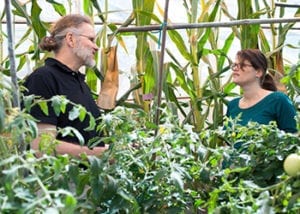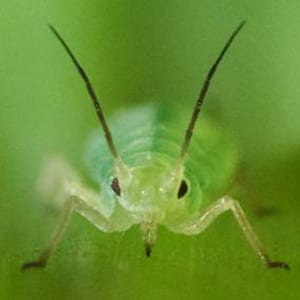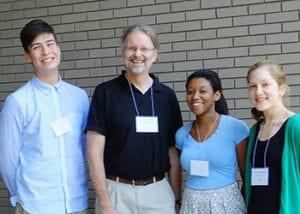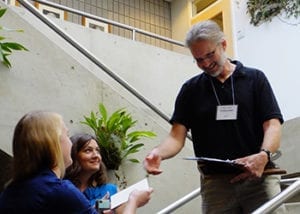News
Jander Unlocks Molecular Pathways of Plants and Empowers People
 We don’t generally see plants as commanders of their ecological destiny. But Professor Georg Jander has seen that, when attacked, plants react. Those reactions happen at the molecular level and Jander has spent more than a decade at the Boyce Thompson Institute for Plant Research (BTI) decoding these chemical signals to harness the power of plants to impact humans and the environment.
We don’t generally see plants as commanders of their ecological destiny. But Professor Georg Jander has seen that, when attacked, plants react. Those reactions happen at the molecular level and Jander has spent more than a decade at the Boyce Thompson Institute for Plant Research (BTI) decoding these chemical signals to harness the power of plants to impact humans and the environment.
Interesting interactions
Jander’s research muse is the aphid, a tiny sap-sucking insect with picky eating habits. Many species are monophagous, feeding only on a single plant.
“Aphids tend to be fairly specific on plants they eat. If they’re not able to feed from a plant, this means the plant has mounted a defense,” said Jander.
The species-specific interactions between aphids and plants are helpful for scientists like Jander who want to find out why certain plants are more or less sensitive to aphid attacks and which molecular pathways lead to resistance. Like other predator-prey relationships in nature, aphids and their plant hosts co-evolved to survive: aphids developed genetically coded mechanisms to reduce the toxic effects of plant defenses, while plant hosts respond to aphid feeding by producing different chemicals or changing the composition of their sap. Research on these interactions often reveals new chemical compounds and their functions.
 Jander also studies aphids because they are destructive agricultural pests, wreaking havoc as primary vectors—or transmitters—of viral plant diseases. To control these diseases, growers have limited choices. There are currently no pesticides to combat plant viruses and aphid-transmitted diseases often evade early detection, requiring growers to take more drastic control measures.
Jander also studies aphids because they are destructive agricultural pests, wreaking havoc as primary vectors—or transmitters—of viral plant diseases. To control these diseases, growers have limited choices. There are currently no pesticides to combat plant viruses and aphid-transmitted diseases often evade early detection, requiring growers to take more drastic control measures.
Powerful pathways
Jander’s work, which involves identifying and mapping regions of DNA in plants that confer resistance to certain aphids, opens doors for using less chemical pesticides by breeding plants with better natural resistance. It’s already moving forward with maize, or corn, the world’s most economically important crop. In a 2013 study, Jander and colleagues identified a region of maize DNA responsible for controlling the level and form of certain chemicals—called benzoxazinoids—that are critical weapons against corn leaf aphids.
“Now, since we have identified the genes that control these chemical changes, breeders will be able to screen and select for specific genes rather than having to do expensive and time consuming traditional selective breeding trials in the field,” Jander said.
 Jander also is working to identify the molecular pathways some plants use to make and disguise toxic amino acids for defense. Soon, Jander will shift focus further toward humans, working on a new project to identify the molecular pathways certain plants use to produce cardiac glycosides, medicinal compounds traditionally used to treat heart ailments. He hopes to unlock the potential to produce and modify these compounds synthetically so scientists can more widely test their effects and develop new medical applications.
Jander also is working to identify the molecular pathways some plants use to make and disguise toxic amino acids for defense. Soon, Jander will shift focus further toward humans, working on a new project to identify the molecular pathways certain plants use to produce cardiac glycosides, medicinal compounds traditionally used to treat heart ailments. He hopes to unlock the potential to produce and modify these compounds synthetically so scientists can more widely test their effects and develop new medical applications.
Career catalyst
In the lab, Jander also is expanding his research impact through intelligent mentoring, starting in high school. Since 2003, Jander has led BTI’s competitive high school internship program with funding from the Ithaca Garden Club and the National Science Foundation, and has hosted local high school students in his lab every year. He also has obtained four grants from the National Science Foundation’s Research Experiences for Undergraduates program, through which BTI employs 15 to 18 interns each summer.
 “When I was in high school, I worked summers in a research lab. I wanted to give that same opportunity to other kids,” Jander said.
“When I was in high school, I worked summers in a research lab. I wanted to give that same opportunity to other kids,” Jander said.
Initially, high school interns are surprised at how much of research is routine work. Yet Jander tries to tailor their internships to areas of interest as they learn basic lab techniques. He also treats high school interns like undergraduates: Jander’s office door is always open but he gives students space to learn on their own.
His work has paid off. Jander now has ten people in his lab, working together to learn and potentially pursue careers in plant science. One former postdoctoral scientist, Clare Casteel (now assistant professor at UC Davis) recently identified a specific protein-encoding region of DNA in the turnip mosaic virus (TMV) genome that makes infected plants more attractive to aphids and helps spread the virus. Jander said Casteel’s work is a significant contribution to the field.
Thankfully for future generations, Jander’s dedication—to plant science and people—seems to be contagious.
“I expect people to do what they need to do to get it [research work] done,” said Jander. “It’s rare that I have to tell them to work harder.”

